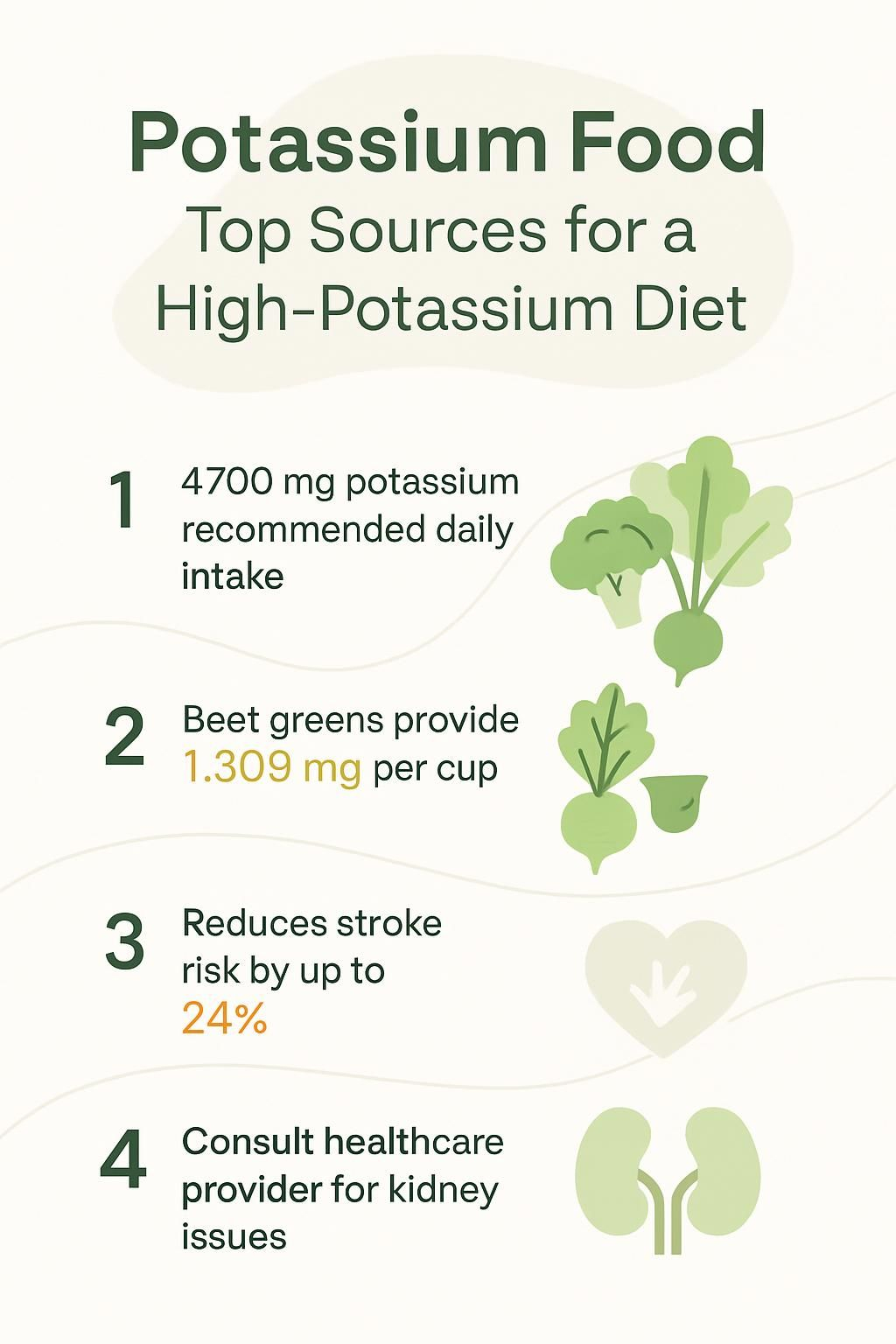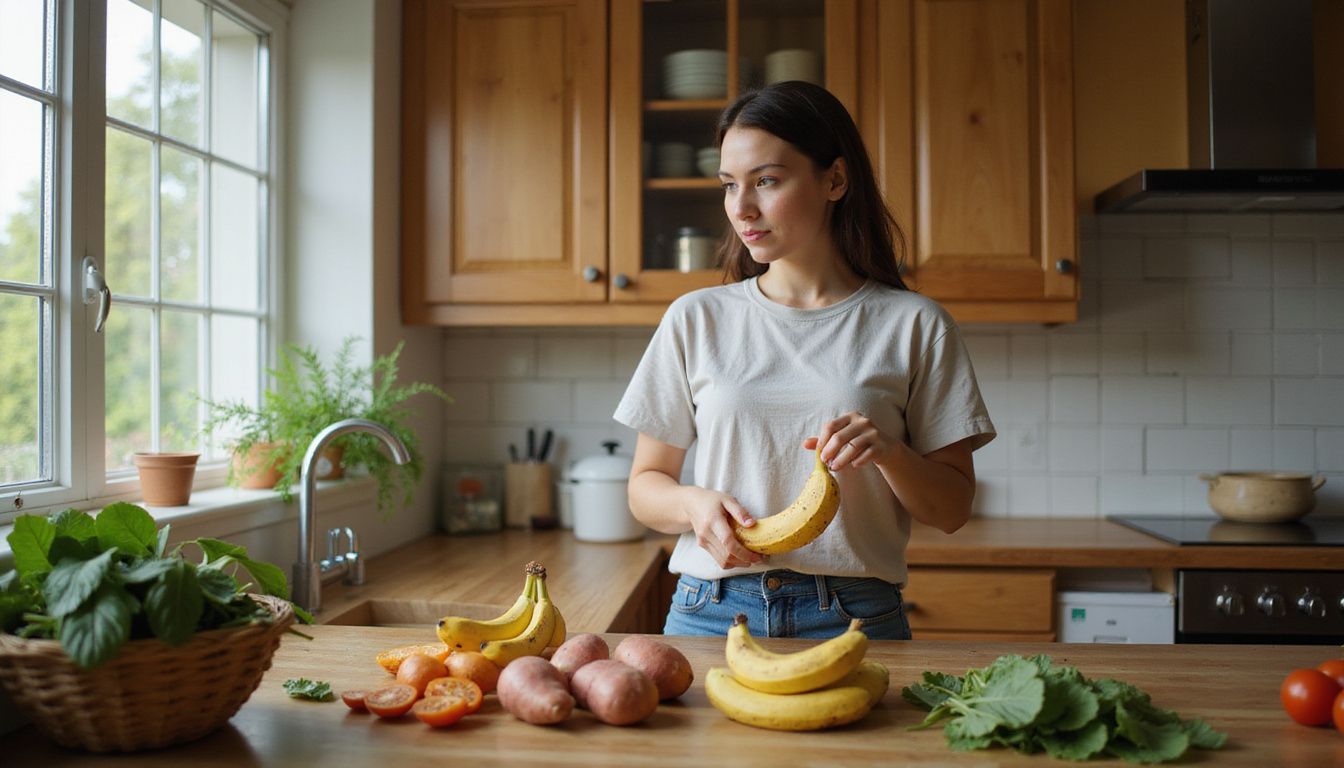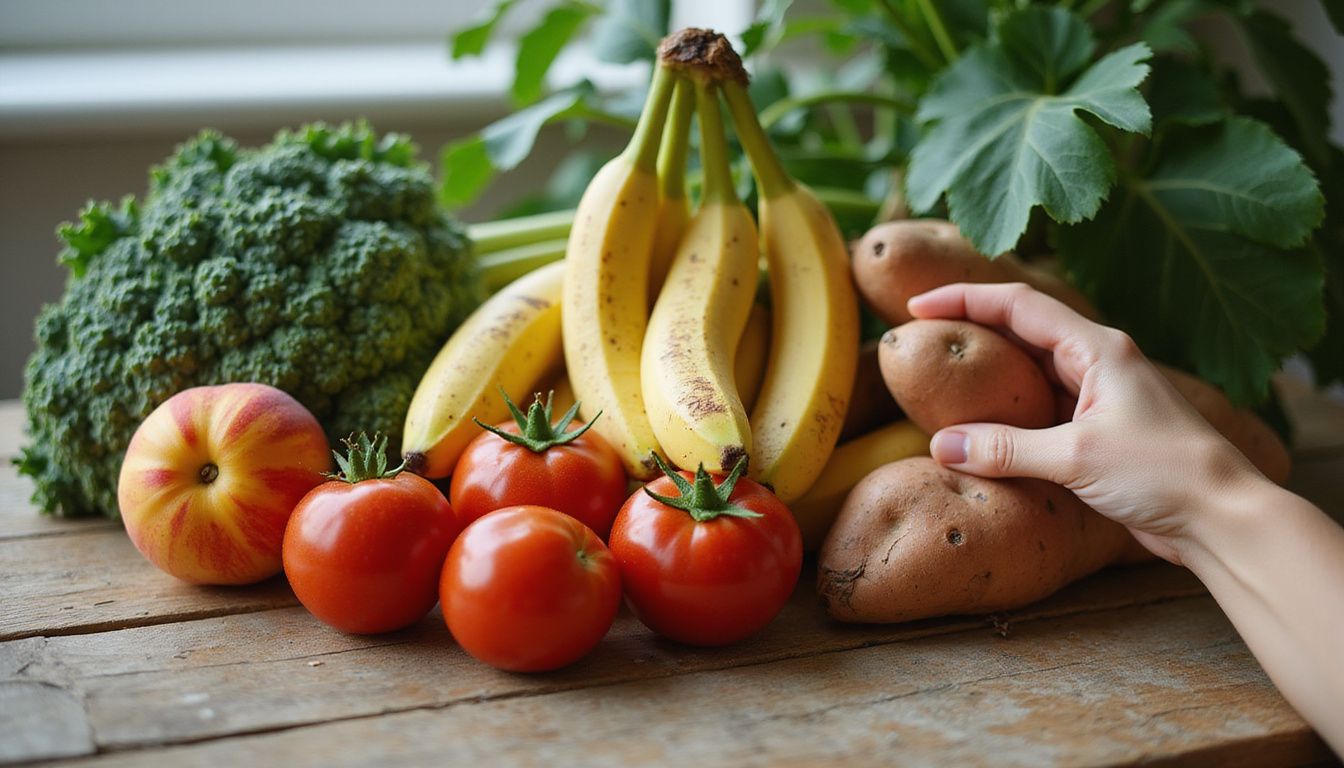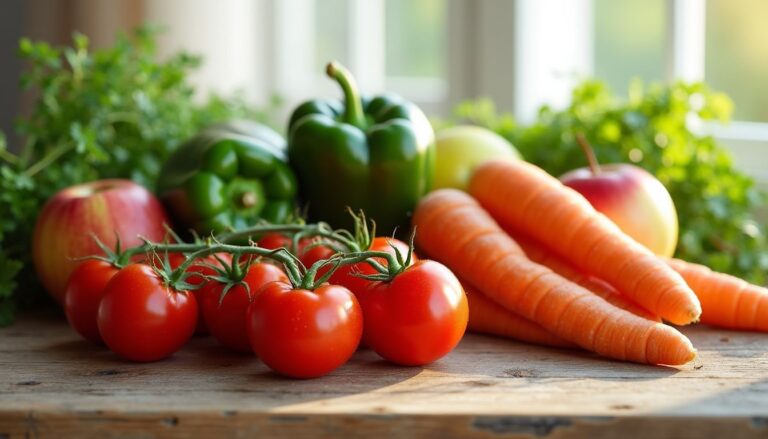Potassium Food: Top Sources For A High-Potassium Diet
Our Nutrition Assistant AI Suite will transform your body. You will lose fat, get toned, and build muscle. Gain confidence and optimal health.
You might wonder which foods deliver enough potassium to support your heart, muscles, and nerves. This mineral and electrolyte helps control fluid balance, nerve signals, and muscle contractions. If you want to lower blood pressure, prevent cramps, or keep energy steady, learning the best potassium-rich foods is a smart first step.
This guide highlights trusted sources of potassium, explains daily needs, and shows easy ways to add more to your meals. You will also see when to be careful, especially if you have kidney problems or take certain medicines.
Key Takeaways
- The FDA suggests healthy adults aim for 4,700 mg of potassium per day to support normal blood pressure and heart function.
- Top sources include beet greens, about 1,309 mg per cup; sweet potatoes, 900-plus mg per cup; bananas, 422 mg per medium fruit; and avocados, about 700 mg each.
- Many Americans get only half their daily goal because they eat too few fruits, vegetables, and legumes.
- Enough potassium supports fluid balance, nerve signaling, muscle contraction, lower stroke risk up to 24 percent, and stronger bones.
- People with kidney disease or those on certain medicines should review intake with a clinician and use supplements or salt substitutes only with guidance.

What is Potassium?

Potassium is a key mineral and electrolyte found naturally in many foods high in potassium. Your body needs it for normal heart rhythm, muscle movement, and nerve function. Think of it as a traffic controller that helps signals move in and out of cells safely.
Why is potassium important for the body?
Potassium supports fluid balance, steadies blood pressure, and helps nerves send clear messages to muscles. A typical serving of foods high in potassium, such as bananas or sweet potatoes, gives 400 to 900 milligrams of potassium per serving.
Your heart relies on steady potassium levels to keep a regular beat and reduce the chance of arrhythmia, which is an abnormal rhythm. Cells use the sodium-potassium pump to move nutrients in and waste out. Enough potassium also helps your kidneys remove extra sodium in urine, which can lower blood pressure and reduce stroke risk by up to 24 percent.
This mineral supports hormone activity, bone strength, and prevents kidney stones. After a long, hot day outside, I once ate a small handful of dried apricots and felt my energy return within minutes.
“Potassium is essential for life because it keeps your muscles moving, nerves firing, and heart beating smoothly.”
How does potassium help maintain health?
Potassium keeps muscles, nerves, and your heart in sync. Low blood potassium, called hypokalemia, can trigger weakness, cramping, irregular heartbeat, and in rare cases paralysis.
It also helps your body flush excess sodium, easing pressure on blood vessels. Diets with plenty of potassium foods can support normal blood pressure. Getting enough may lower kidney stone risk because the kidneys reabsorb more calcium, which reduces the calcium that forms stones. Better calcium handling also supports bone density over time.
Many potassium-rich foods, such as squash, lentils, legumes, milk, yogurt, bananas, and dried fruits, are naturally low in sodium. That makes them a smart fit for most healthy eating plans.
How Much Potassium Do You Need?
Your daily need depends on age, health, and activity. Meeting the recommended intake supports heart health and helps prevent deficiency symptoms.
What is the recommended daily potassium intake?
The Food and Drug Administration recommends 4,700 mg of potassium per day for healthy adults. This target supports normal blood pressure and overall heart health. Labels now list potassium, which helps you track foods like legumes, avocados, potatoes, salmon, and pulses.
Most people only reach about half of that goal because they eat too few fruits, vegetables, and beans. Supplements should not replace food unless a clinician advises it. When I added bananas and sweet potatoes a few times each week, my energy during sports practices improved.
Aiming for at least 4,700 mg of potassium from foods helps most people meet their needs without relying on pills.
What factors affect potassium requirements?
Several conditions change potassium needs. Chronic kidney disease often requires a low-potassium diet, since damaged kidneys clear potassium poorly. Some diuretics and blood pressure medicines can raise potassium levels, so dosing and food choices may need adjustments.
Heart failure, use of potassium-based salt substitutes, uncontrolled diabetes, severe burns or injuries, and Addison’s disease can also affect potassium balance. Dehydration shifts how much potassium you lose in urine or sweat.
During hospital recovery, I saw how fluids and medicines quickly change electrolyte needs, including potassium. If you use dietary supplements or salt substitutes, talk with a healthcare provider, especially if you have kidney or heart conditions.
Benefits of a High-Potassium Diet
A potassium-forward plate can support healthier blood pressure, stronger bones, and a steadier heartbeat. Small shifts in your grocery cart can add up fast.
How does potassium support heart health?
Potassium helps your body remove extra sodium, which lowers blood pressure and strain on the heart. It also relaxes blood vessel walls so blood moves with less resistance.
Eating more potassium from foods like prunes, raisins, yams, chard, and fish such as sardines can lower the risk of cardiovascular disease and stroke. Research supported by the National Institutes of Health links balanced potassium levels with proper heart contractions. Both too little and too much can be dangerous, so aim for steady intake.
How does potassium regulate blood pressure?
Higher potassium intake helps the kidneys flush sodium. Less sodium in your blood usually means less pressure on vessel walls. Kidneys balance potassium and sodium in blood plasma, and potassium also helps vessels relax.
Experts recommend 4,700 mg daily to help manage blood pressure. Potassium-rich foods like soy milk, honeydew, dried fruits, sweet potatoes, beans, and avocados support this effect. If you have kidney failure or fluid limits, work with your care team to manage protein, fluids, and minerals safely.
How does potassium improve muscle and nerve function?
Muscle contraction and relaxation rely on potassium. Low intake can lead to cramps, weakness, and fatigue. Severe deficiency may cause twitching or even paralysis.
Potassium supports nerve signaling, known as depolarization, which coordinates muscle movement. It also helps regulate hormone activity that affects muscle and nerve cells. After long runs, I eased leg cramps by choosing more potassium-rich foods like potatoes and bananas.
How can potassium prevent kidney stones and bone loss?
Kidney stones often result from calcium buildup. Potassium supports the kidneys so more calcium is reabsorbed into the body and less stays in urine. That lowers the chance of stone formation.
Enough potassium also helps reduce acid load from high-sodium diets, which protects bone mineral density. Studies in the United States show that steady potassium intake supports stronger bones in older adults.
Next, see the food sources that make reaching your daily target much easier.
Top Food Sources of Potassium
Potassium is found in many foods. Knowing the highest sources helps you meet your daily needs without relying on pills.
Fruits that are high in potassium
Fruits are a simple way to raise potassium intake. Many offer more potassium than you might expect.
- Sapote or sapodilla, 794 mg per cup.
- Jackfruit, 739 mg per cup.
- Prune juice, 707 mg per cup, plus fiber for digestion.
- Dried apricots, 755 mg per half cup, a concentrated source.
- Guava, 688 mg per cup.
- Passion fruit juice, 687 mg per cup.
- Bananas, about 422 mg per medium fruit, portable and quick.
- Oranges, around 237 mg each; orange juice, up to 496 mg per cup.
Vegetables like spinach and sweet potatoes also provide high levels, giving you more ways to reach the recommended intake.
Are bananas a good source of potassium?
Yes. One medium banana supplies about 422 mg of potassium. It is one of the most convenient options, and your body absorbs it quickly.
Adding a banana to breakfast or a workout snack can help reduce cramps. Other strong options include sweet potatoes, avocados, and leafy greens.
Do oranges provide enough potassium?
Oranges offer a helpful amount of potassium. Depending on the form, a serving can provide between 306 and 794 mg. Half a cup of orange juice gives more than 200 mg.
Both whole oranges and juice can help you reach your daily goal. I often grab a glass with breakfast, which keeps my energy steady during exercise.
How much potassium is in avocados?
One medium avocado has about 700 mg of potassium. Even half an avocado adds more than a small banana or orange.
Make guacamole, add slices to whole grain toast, or toss cubes into salads. Avocados also provide heart-friendly fats that keep you satisfied.
Is watermelon rich in potassium?
Watermelon contains less potassium than avocados or bananas. One cup of diced watermelon offers about 170 mg.
It is excellent for hydration on hot days. If your goal is a big potassium boost, choose higher-potassium options like beans or spinach.
What potassium does dried apricot contain?
Dried apricots are packed with potassium, about 755 mg per half cup. They are often listed among the highest-potassium dried fruits.
They make easy snacks or salad toppers. If you follow a low-potassium diet or have kidney issues, limit portions and ask your clinician for guidance.
Vegetables that are high in potassium
Vegetables are powerful potassium sources and fit easily into daily meals.
- Cooked beet greens, about 1,309 mg per cup. Add to soups or stir-fries.
- Cooked Swiss chard, 961 mg per cup. Sauté or mix into pasta.
- Cooked lima beans, 955 mg per cup. Great for salads and stews.
- Baked potato with skin, 926 mg per medium. Keep the skin for more minerals.
- Cooked sweet potatoes, 900-plus mg per cup. A hearty side dish.
- Cooked yams, about 911 mg per cup.
- Cooked acorn squash, about 896 mg per cup.
- Cooked spinach, roughly 561 to 1,309 mg per serving, depending on portion.
- Amaranth leaves and breadfruit, 561 to 1,309 mg each, depending on serving size.
At home, swapping white rice for roasted squash or sweet potatoes boosted flavor and helped me hit potassium targets without a supplement.
Are sweet potatoes high in potassium?
Yes. A medium sweet potato, about 130 grams, provides around 541 mg of potassium. That makes it a go-to side for many meals.
Sweet potatoes are nutrient dense and low in sodium. Bake, mash, or roast them for a simple way to support muscle and heart health.
How much potassium is in spinach?
Cooked spinach delivers about 839 mg of potassium per cup. Depending on preparation and portion, a cup can range between 561 and 1,309 mg.
Spinach is also rich in calcium, iron, magnesium, and fiber. Stir it into eggs, pasta, or soups for an easy boost.
Do potatoes have significant potassium?
They do. A medium baked potato with skin contains about 926 mg of potassium. About one quarter of that comes from the skin, so eat the whole potato when you can.
Potatoes are affordable, filling, and low in sodium. One baked potato can provide close to 20 percent of your daily target.
Is Swiss chard a potassium-rich vegetable?
Yes. One cup of cooked Swiss chard contains 961 mg of potassium, about 20 percent of a day’s goal.
Add it to salads, soups, or serve it as a warm side. I often pair cooked chard with roasted squash and a sprinkle of nuts for extra flavor.
How much potassium is in beets?
Beet greens are one of the richest vegetable sources. One cup of cooked beet greens delivers about 1,309 mg of potassium, more than the same serving of potatoes or spinach.
They are low in sodium and high in minerals. Toss them into stir-fries or soups to raise your intake.
Beverages that contain potassium
Several drinks contribute meaningful potassium, which can be handy if you prefer sipping your nutrients.
- Prune juice, 707 mg per cup.
- Orange juice, more than 200 mg per half cup.
- Tomato and apricot juices, significant amounts that support heart and nerve function.
- Milk and yogurt, over 200 mg per cup, plus protein.
- Soy milk, about 287 mg per cup.
- Coconut water, naturally rich in potassium and hydrating.
- Grapefruit juice and many vegetable blends, helpful amounts.
- Spacing these beverages across the day makes hitting goals easier.
Switching from sugary drinks to potassium-rich choices supports hydration and nutrient balance.
Is coconut water a good potassium source?
Yes. One cup of coconut water supplies about 600 mg of potassium, more than many common drinks.
Many athletes use it to replace electrolytes after workouts. It has fewer calories than most sodas and works well in smoothies or on its own.
Do fruit and vegetable juices provide potassium?
They do. Orange juice provides more than 200 mg per half cup, and prune juice delivers 707 mg per cup. Tomato, apricot, and grapefruit juices also supply helpful amounts.
Juices fit well if you struggle to eat enough produce. They contribute potassium, vitamins, and fluid in one step.
Pulses and legumes rich in potassium
Pulses and legumes offer plant protein and impressive potassium. Add them to soups, salads, and grain bowls to increase daily intake.
- Cooked lima beans, 955 mg per cup.
- Pinto beans, kidney beans, soybeans, and lentils, strong sources per serving.
- Cooked soybeans, about 890 mg per cup.
- Lentils boost potassium without much sodium.
- Beans are often recommended on professional potassium handouts.
- A 3-ounce serving of cooked beans works well on busy days.
Are beans high in potassium?
Yes. One cup of cooked lima beans provides about 955 mg. Pinto, kidney, and soybeans are also rich in potassium.
Beans appear on most high-potassium lists because they offer minerals, fiber, and protein all at once. I often add black beans or chickpeas to salads for taste and nutrition.
How much potassium do lentils contain?
One cup of cooked lentils has around 731 mg of potassium. That makes them a practical choice for heart and muscle health.
Lentils are low in sodium and high in protein and fiber. Use them in soups, salads, or stews for a nutrient-dense meal.
Other potassium-rich foods
Many pantry items and proteins contribute helpful amounts of potassium.
- Salt substitutes with potassium chloride can deliver about 470 mg per quarter teaspoon. People with kidney disease should avoid them unless approved.
- Blackstrap molasses, about 498 mg per tablespoon. Try it in oatmeal or smoothies.
- Almonds and pistachios, 200 to 290 mg per ounce.
- Chicken, turkey, beef, salmon, and canned tuna, roughly 153 to 332 mg per 3-ounce serving.
- Brown rice and wild rice, more than 80 mg per cooked half cup.
- Bran cereal, up to 400 mg per cup, plus fiber.
- Whole wheat bread or pasta has more potassium than white versions. Two slices of whole wheat bread provide about 138 mg.
These foods fit easily into daily meals if you watch portions and choose simple cooking methods.
Which fish are high in potassium?
Tuna, halibut, cod, trout, and rockfish provide high amounts per serving. Skipjack tuna has about 444 mg in 3 ounces. Salmon gives 326 mg per 3 ounces, and mullet offers up to 389 mg.
Atlantic mackerel, sardines, and pollock are good low-mercury options. Clams contain about 534 mg per 3-ounce serving. Canned tuna has less, around 153 mg per 3 ounces, but still helps you reach your goal. I like serving trout for dinner to get both potassium and protein.
Are salt substitutes a good potassium source?
Many salt substitutes use potassium chloride instead of sodium chloride. They can lower sodium intake and raise potassium at the same time.
Some provide around 440 mg of potassium per quarter teaspoon. Use only with medical guidance, especially if you take ACE inhibitors, certain diuretics, or have kidney disease.
Tips for Incorporating Potassium-Rich Foods into Your Diet
Simple meal changes can lift your potassium levels without a supplement.
How to add more fruits and vegetables to your meals?
Aim for at least five servings of fruits and vegetables per day. Choose options high in potassium such as bananas, oranges, spinach, and potatoes. Add spinach or sweet potatoes to omelets, casseroles, or grain bowls. Pour a small glass of fruit or vegetable juice with breakfast or as a snack.
Top salads and soups with beans or lentils for a potassium boost. Carry dried apricots or kiwi for quick snacks. Blend bananas, oranges, or avocado into smoothies. A simple list or handout can help you pick the best produce in stores.
What are good potassium-rich snack alternatives to salty snacks?
Swap chips for bananas, dried apricots, or raisins. Each serving gives more than 300 mg of potassium and helps muscle and heart function.
Try yogurt for protein plus potassium. Bake a potato, make sweet potato wedges, or choose whole wheat crackers with bean dip. Fresh vegetables like cucumbers and bell peppers add crunch without extra salt. A small glass of orange or prune juice can also help.
When should you use potassium-based salt substitutes?
Potassium-based salt substitutes can cut sodium while adding potassium. Many professional lists include them as concentrated sources.
Only use these products with medical supervision. People with chronic kidney disease or those taking certain medicines may need to avoid them. Always confirm safe serving sizes with your healthcare provider.
Should You Take a Potassium Supplement?
Supplements can help in specific cases, but food sources are preferred for most healthy people. Seek medical advice before starting any supplement.
When might potassium supplements be necessary?
A clinician may recommend supplements if you have hypokalemia, which is a serious low level of potassium in the blood. Causes include vomiting, diarrhea, certain diuretics, and some chronic illnesses like kidney disease.
Supplements may also be used if you cannot meet needs through food due to medical restrictions. In urgent situations, intravenous potassium is given in a hospital. Follow your clinician’s dose and directions carefully.
What are the potential side effects of potassium supplements?
Supplements can cause fatigue, cramps, nausea, and chest discomfort. Some people develop irregular heartbeat or breathing issues. High potassium, called hyperkalemia, can be dangerous and may harm the heart or kidneys.
They can also interact with medicines such as certain blood pressure drugs or diuretics. I once took a potassium supplement without advice and felt nauseated and tired all day. Use supplements only as directed by your healthcare provider.
Frequently Asked Questions About Potassium
Here are clear answers to common questions about potassium and your diet.
What are the signs of potassium deficiency?
Common signs include cramps, fatigue, and weakness. Irregular heartbeat can also signal low levels, known as hypokalemia. In severe cases, low blood pressure or sudden paralysis may occur. Children can be at higher risk because their reserves are smaller.
After several days without potassium-rich foods like bananas or spinach, symptoms may appear. On a trip where I ate very little produce, I felt tired with muscle spasms until I added more fruits and vegetables back.
Can consuming too much potassium be harmful?
Yes. Too much can lead to hyperkalemia, which means dangerously high potassium in the blood. That can trigger irregular heartbeats or even a heart attack. Symptoms may include fatigue, nausea, or trouble breathing.
People with kidney disease are at higher risk because the kidneys do not clear potassium well. Your safe range depends on your health, medicines, and diet. Pay attention to intake from bananas, potatoes, avocados, spinach, beans, coconut water, and supplements.
What are the best practices for balanced potassium intake?
Aim for 4,700 mg daily, as recommended by the FDA. Include bananas, sweet potatoes, beans, fish, spinach, and dairy products. Use the Nutrition Facts label to track your progress and spot shortfalls.
Watch for symptoms like cramps, which can signal low intake. Avoid excess if you have kidney problems or take certain medicines. I found that adding leafy greens and lentils to lunch kept my energy steady in the afternoon.
Conclusion
Eating potassium-rich foods supports your heart, nerves, and muscles. Fruits like bananas, oranges, and dried apricots work well as easy snacks. Vegetables such as potatoes, spinach, and beets add significant amounts at mealtime.
Drinks like coconut water and foods such as beans or lentils also help. Most healthy people can reach their goal through whole foods rather than a potassium supplement. This article is for educational purposes only and does not replace medical advice.
Tracking your intake can lower the risk of high blood pressure and cramps. With a few smart choices, you can keep potassium levels in a healthy range.
FAQs
1. What are the top sources of potassium-rich foods for a high-potassium diet?
Potatoes, bananas, white beans, spinach, and yogurt provide some of the highest levels of potassium per serving. For example, one medium baked potato contains about 925 milligrams; a cup of cooked white beans offers around 1,000 milligrams.
2. How much potassium does an adult need each day?
Most adults should aim for about 4,700 milligrams daily according to guidelines from the National Institutes of Health (NIH). This amount supports healthy blood pressure and muscle function.
3. Why is eating enough potassium important for health?
A diet rich in potassium helps lower blood pressure and reduces risk for heart disease and stroke. Studies show that people who eat more fruits and vegetables with high potassium have better cardiovascular outcomes.
4. Can you get too much potassium from food alone?
Healthy kidneys remove extra potassium efficiently so it is rare to reach dangerous levels through food alone if kidney function is normal. People with chronic kidney problems may need to limit intake after consulting their doctor or nutritionist.
Summary: Potatoes, bananas, legumes like white beans, leafy greens such as spinach, and dairy products like yogurt are leading sources of dietary potassium. Meeting daily needs supports heart health while most people can safely consume these foods unless advised otherwise by a healthcare provider due to medical conditions affecting kidney function or electrolyte balance.
Personal Note: After adding more potatoes and leafy greens to my meals last year on my doctor’s advice I noticed improved energy during exercise which matches research showing benefits linked to higher dietary potassium intake [NIH Office of Dietary Supplements].







